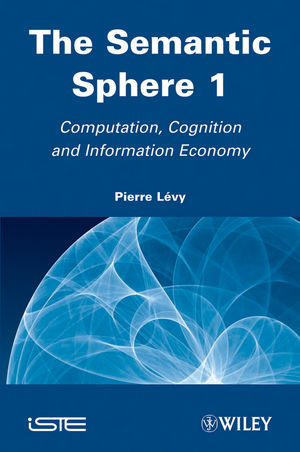
The Semantic Sphere 1
ISTE Ltd and John Wiley & Sons Inc (Verlag)
978-1-84821-251-0 (ISBN)
Pierre Lévy is a?professor at the Department of Communication of the Faculty of Arts at the University of Ottawa and Canada Research.? He was endowed with a Canada Research Chair in Collective Intelligence at the University of Ottawa in 2002. His CRC in Collective Intelligence was the first academic institution worldwide to be explicitly focused on this new scientific field. He is the author of 12 books about the cultural and social impacts of digital technologies that have been translated into more than 10 languages. He has received several scientific awards in France, Italy, and Canada.
Acknowledgements xv
Chapter 1. General Introduction 1
1.1. The vision: to enhance cognitive processes 2
1.2. A transdisciplinary intellectual adventure 5
1.3. The result: toward hypercortical cognition 27
1.4. General plan of this book 35
PART 1. THE PHILOSOPHY OF INFORMATION 37
Chapter 2. The Nature of Information 41
2.1. Orientation 41
2.2. The information paradigm 45
2.3. Layers of encoding 56
2.4. Evolution in information nature 66
2.5. The unity of nature 69
Chapter 3. Symbolic Cognition 75
3.1. Delimitation of the field of symbolic cognition76
3.2. The secondary reflexivity of symbolic cognition 78
3.3. Symbolic power and its manifestations 80
3.4. The reciprocal enveloping of the phenomenal world and semantic world 82
3.5. The open intelligence of culture 84
3.6. Differences between animal and human collective intelligence 85
Chapter 4. Creative Conversation 89
4.1. Beyond “collective stupidity” 89
4.2. Reflexive explication and sharing of knowledge 92
4.3. The symbolic medium of creative conversation 103
Chapter 5. Toward an Epistemological Transformation of the Human Sciences 113
5.1. The stakes of human development 113
5.2. Critique of the human sciences 120
5.3. The threefold renewal of the human sciences 125
5.4. The Ouroboros 133
Chapter 6. The Information Economy 135
6.1. The symbiosis of knowledge capital and cognitive labor 136
6.2. Toward scientific self-management of collective intelligence 140
6.3. Flows of symbolic energy 144
6.4. Ecosystems of ideas and the semantic information economy 148
6.5. The semantic information economy in the digital medium 154
PART 2. MODELING COGNITION 159
Chapter 7. Introduction to the Scientific Knowledge of the Mind 161
7.1. Research program 161
7.2. The mind in nature 165
7.3. The three symbolic functions of the cortex 171
7.4. The IEML model of symbolic cognition. 176
7.5. The architecture of the Hypercortex 184
7.6. Overview: toward a reflexive collective intelligence 187
Chapter 8. The Computer Science Perspective: Toward a Reflexive Intelligence 189
8.1. Augmented collective intelligence 189
8.2. The purpose of automatic manipulation of symbols: cognitive modeling and self-knowledge 194
8.3. The means of automatic manipulation of symbols: beyond probabilities and logic 202
Chapter 9. General Presentation of the IEML Semantic Sphere 207
9.1. Ideas 208
9.2. Concepts 213
9.3. Unity and calculability 217
9.4. Symmetry 220
9.5. Internal coherence 225
9.6. Inexhaustible complexity 230
Chapter 10. The IEML Metalanguage 235
10.1. The problem of encoding concepts 235
10.2. Text units 238
10.3. Circuits of meaning 241
10.4. Between text and circuits 244
Chapter 11. The IEML Semantic Machine 253
11.1. Overview of the functions involved in symbolic cognition 253
11.2. Requirements for the construction of the IEML semantic machine 258
11.3. The IEML textual machine (S) 261
11.4. The STAR (Semantic Tool for Augmented Reasoning) linguistic engine (B) 264
11.5. The conceptual machine (T) 267
11.6. Conclusion 270
Chapter 12. The Hypercortex 275
12.1. The role of media and symbolic systems in cognition 275
12.2. The digital medium 277
12.3. The evolution of the layers of addressing in the digital medium 284
12.4. Between the Cortex and the Hypercortex 289
12.5. Toward an observatory of collective intelligence 291
12.6. Conclusion: the computability and interoperability of semantic and hermeneutic functions 296
Chapter 13. Hermeneutic Memory 299
13.1. Toward a semantic organization of memory 299
13.2. The layers of complexity of memory 302
13.3. Radical hermeneutics 304
13.4. The hermeneutics of information 308
13.5. The hermeneutics of knowledge 312
13.6. Wisdom 317
13.7. Collective interpretation games 318
Chapter 14. The Perspective of the Humanities: Toward Explicit Knowledge 323
14.1. Context 323
14.2. Methodology: the digital humanities 327
14.3. Epistemology: explicating symbolic cognition 331
Chapter 15. Observing Collective Intelligence 341
15.1. The semantic sphere as a mirror of concepts 341
15.2. The structure of the cognitive image 346
15.3. The two eyes of reflexive observation 350
Bibliography 353
Index 377
| Verlagsort | London |
|---|---|
| Sprache | englisch |
| Maße | 158 x 236 mm |
| Gewicht | 680 g |
| Themenwelt | Informatik ► Theorie / Studium ► Künstliche Intelligenz / Robotik |
| Technik ► Elektrotechnik / Energietechnik | |
| ISBN-10 | 1-84821-251-8 / 1848212518 |
| ISBN-13 | 978-1-84821-251-0 / 9781848212510 |
| Zustand | Neuware |
| Haben Sie eine Frage zum Produkt? |
aus dem Bereich


